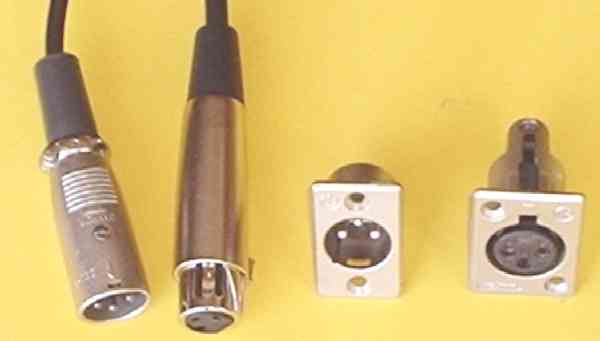XLR connector
|
|
The XLR connector is a rugged electrical connector design. XLR plugs and sockets are used mostly in professional audio and video electronics cabling applications. Home audio and video electronics normally use RCA connectors.
In reference to its original manufacturer, Cannon (now part of ITT), the connector is colloquially known as a cannon plug or canon. Originally called by code X, subsequent versions with a Latch and Rubber gasket led to the acronym XLR. Many companies now make XLRs.
Patterns of XLR connector
The most common is the 3-pin XLR3, used almost universally as a balanced audio connector for high quality microphones and connections between equipment. The XLR5, with five smaller pins than the XLR3, is the standard connector for DMX digital lighting control. XLR4s with four pins are used for ClearCom and Tecpro intercom systems and the older AMX analog lighting control.
Many other types exist, with various pin numbers. Most notable are two now obsolete 3-pin patterns manufactured by ITT Cannon. The power Cannon had red insulation, and was intended as a mains power connector, but has been superseded by the IEC mains connector and increasingly, more recently, the PowerCon connector developed by Neutrik. The loudspeaker Cannon had blue or white insulation (depending on its gender), was intended for connections between audio power amplifiers and loudspeakers, and was superseded in professional audio applications by the Neutrik Speakon connector.
XLR3 connectors

Left to right: Cannon XLR3-12C (line), Switchcraft X3F (line), Neutrik NC3MP panel, Neutrik NC3FP panel
EIA Standard RS-297-A describes the use of the XLR3 for audio signal level applications. Some audio equipment manufacturers reverse the use of pin 2 (properly the normal input) and pin 3 (inverting input). This reflects their usage since before any standard existed. Pin 1 is always earth, and many connectors connect it internally to the connector body.
| Pin | Function |
|---|---|
| 1 | Chassis ground (cable shield) |
| 2 | Normal polarity ("hot") |
| 3 | Inverted polarity ("cold") |
An XLR3M (male) connector is used for an output and an XLR3F (female) for an input. Thus a microphone will have a built-in XLR3M connector, and signal cables such as microphone cables will each have an XLR3F at one end and an XLR3M at the other. At the stage box end of a multicore cable, the inputs to the mixing desk will be XLR3F connectors, while the returns to the stage will be XLR3M connectors. Similarly, on a mixing desk, the microphone inputs will be XLR3F connectors, and any balanced outputs XLR3M connectors.
At one time XLR3 connectors were also used extensively on loudspeaker cables, as when first introduced they represented a new standard of ruggedness, and economic alternatives were not readily available. The convention was that a 2-conductor loudspeaker cable had XLR3F connectors on both ends, to distinguish it from a 3-conductor shielded signal level cable which has an XLR3F at one end and an XLR3M at the other. Either pin 2 or 3 was live, depending on the manufacturer, with pin 1 always the 'earthy' return. This usage is now both obsolete and dangerous to equipment but is still sometimes encountered, especially on older equipment. For example, some loudspeakers have a built-in XLR3M as an input connector.
External links
- Audio usage (http://www.clarkwc.com/PinOutXLRBalanced.htm)
- Lighting control usage (http://www.dmx512.com/web/light/dmx512/pinouts.htm)de:XLR (Steckverbindung)
